Before this week, I hadn’t been to the grocery store since early December. That’s not to say I haven’t bought any food. Although, I haven’t bought a whole lot. There’s the almost weekly visits to the farmers market. Plus a few random exploits—holiday shopping at Pike Place Market or stopping at local shops while in the area. These purchases result from happenstance more than anything else. As usual, December’s grocery trip was motivated by savings rather than necessity. But I’m willing to bet I’ve been eating a far wider range of meals than most people ever do. Cook or not. Yes, it is possible to make nutritious, tasty, and creative meals without going to the store. I’m always trying to show you how to do that. Today, I want to focus on it.
Your Freezer
Yes, I know I’m always yammering on about the freezer. It’s because it’s so important. You might have the impression that it’s all about convenience. While that’s definitely a factor, if that’s all it was, I’d tell you to go to the store and stock up on frozen foods. But I never say that. It’s fine to buy frozen foods. In fact, in winter, it’s often a better choice than buying fresh foods. Local frozen fruit is more sustainable than fresh fruit from across the country. Not to mention a tastier and cheaper option. Speaking of, a great way to save money is buying fresh foods from farmers during the harvest season. Then freeze the produce yourself. This is an especially good option if you have access to bulk discounts and/or “seconds“.
Convenience and price aside, the number one reason to learn how to use your freezer is to make better meals. At some point, this advantage becomes obvious. But only once you begin to see every single ingredient as a flavor enhancer for another meal. A freezer is not required to make this concept work. It sure makes things easier though when the alternative is the compost bin.
Okay, so let’s get to it and I’ll show you what I’m talking about with examples.
Pulling Ingredients Out of the Freezer for Last-Minute Meals
We’ll start simply … good bread. Keep frozen slices on hand, whether you make it at home or buy it from a local bakery. This week, I had both homemade and purchased bread.
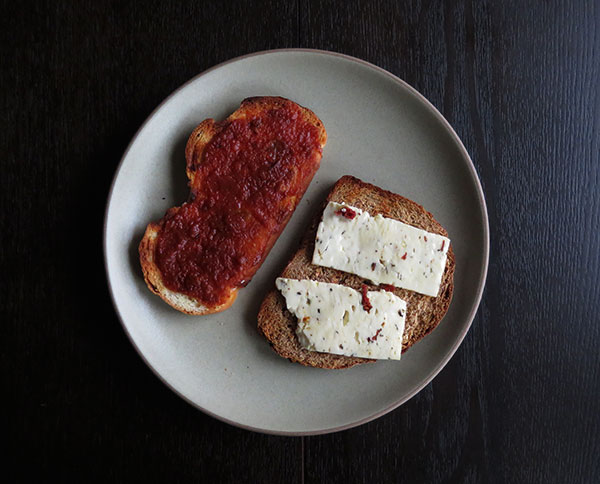
Pancakes on the weekend? Yes! With nothing specific in mind, I found this recipe in my kitchenlister account. I pulled out bananas and blackberries from the freezer. I threw these pancakes together using other pantry staples. Instead of fresh bananas and chocolate syrup, I made an easy blackberry sauce. Two ingredients: frozen blackberries and pomegranate molasses. Fruit sauces are so simple to make and taste much better than anything you can buy.
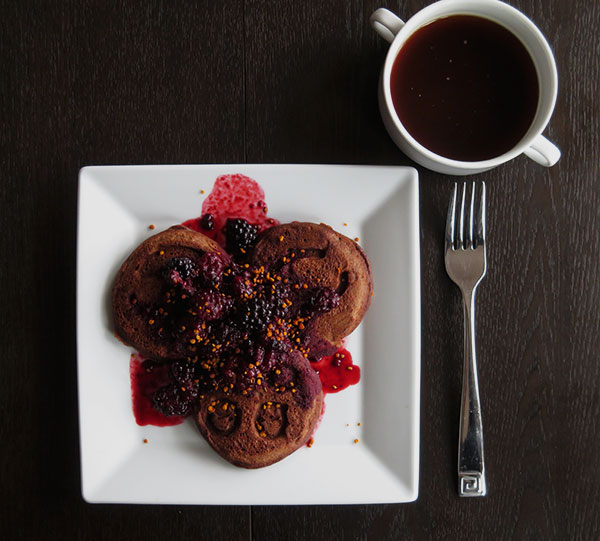
The bonus came Monday morning when we ate pancakes again for breakfast. When making pancakes or waffles, I always make enough for leftovers. I reheat pancakes or waffles in the toaster oven (directly on the rack). A toaster would work too. Reheat the fruit sauce on the stove or in the microwave. How’s that for a way to start a Monday?
Same Concept, Different Appliance: The Fridge
Tastes better than a protein bar:
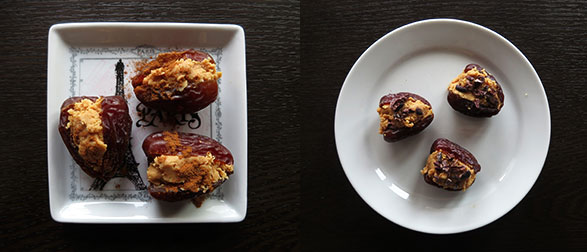
Other nut butters work too if you don’t do peanut butter. I’m sure there’s endless variations on this theme that I haven’t thought of yet. But don’t worry, I’m working on it … (Update: Here’s a couples ideas—stuff dried apricots or figs instead, or how about a version for dessert?)
As a side note, I store all nuts, seeds, and nut/seed products in the fridge. Nuts do go rancid quickly so it’s best to find a place for them in your fridge. This is even more important if your peanut butter is nothing more than ground up peanuts. Actually, I store my dates in the fridge too.
This just wouldn’t be a blog post without:
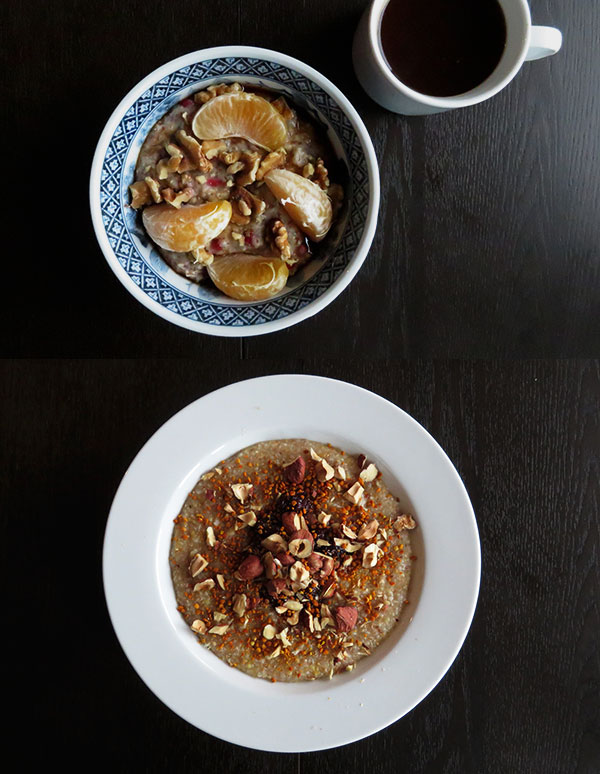
I always keep a variety of hot cereals in my fridge along with frozen fruit in my freezer. This practice ensures I have something easy and healthy available for breakfast. I also receive various home-canned fruits and condiments from my mom. Hence the cranberry-pear chutney. In all honesty, I neglected to read the label when I grabbed the jar and thought it was rhubarb sauce. But once I’d opened the jar, I went ahead and used it anyway. And now I can confirm, fruit chutney is a good topping for hot cereal!
Transforming One Dinner into Another
One of my first blog posts dealt with the idea of transforming leftover meals into something new. While it’s a good way to spark creativity, sometimes you end up with something inspired. Drained from the weekend’s activities, Matt made a super simple pasta dish for us on Sunday night. (Note we still managed NOT to eat up our leftovers.) The sauce is one he’s been making for years. It’s a basic pasta sauce tossed together with actual pantry staples. You know, one that doesn’t involve fresh parsley.
Sorry for the brief interruption. Minor rant coming: fresh herbs are not pantry staples. Maybe you can come up with some elaborate way of keeping them fresh for weeks. However, for most of us, treating fresh herbs like staples only leads to a lot of waste. The one exception for me is fresh rosemary. There’s a pot of it outside that I haven’t managed to kill yet.
Back to the sauce. The five ingredients are olive oil, butter, garlic, salt, and pepper. It became our go-to for the on-the-verge-of-ordering-pizza kind of nights. With a liberal grating of cheese, it’s far better than anything out of a box or jar. One caveat: I do prefer it with white, rather than whole wheat pasta, unless you add a bunch of veggies to it.
Of course, my slow-roasted tomatoes from the freezer elevated the dish. In any case, too much pasta turned into one of the best frittatas I have every made. It was also very simple. Eggs, the sauced capellini, plum tomatoes, and basil-tomato feta cheese from Appel Farms. I had the tomatoes in the freezer and had saved the feta from my cheese share. First, I stirred everything together without the feta. After adding the mixture to the pan, I sprinkled the cubes of cheese on top. Once the underside had cooked, I finished the frittata in the oven. For a garnish, I roasted butternut squash seeds in olive oil, salt, pepper and fresh rosemary. (You’ll recall I made two dishes with butternut squash last week. I can now report that the seeds do in fact keep for a few days in the fridge until you get around to roasting them. Did you know squash and pumpkin seeds are a simple-to-make, high-protein snack?)
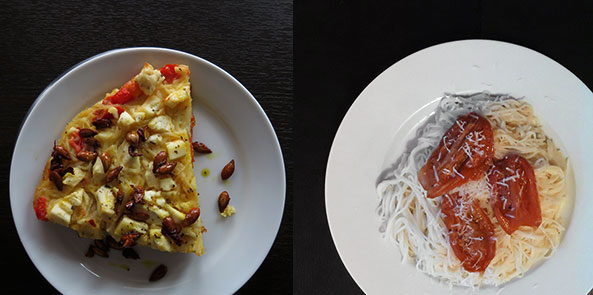
What’s striking in a simple meal like this is how important the ingredients are. These were organic tomato seconds I bought in bulk for $2.25 per pound at their peak in late summer. The flavor is so superior to even good-quality canned tomatoes. (I know you’re not even going to ask me about those tasteless, winter tomatoes.) The eggs are not “cage-free”—an almost useless term—but pasture-raised with exceptional flavor. A full-flavored cheese like feta completes the dish. Even better if it’s an artisan cheese. As I’ve said before, it’s the quality of your ingredients that makes the meal. Frittatas are so easy to put together without a recipe. Leftovers are versatile: serve over salad or in a sandwich, or as an accompaniment to soup. Watch my Youtube video for more tips.
You Can Even Use Recipes
As a CSA member, I get A LOT of beets throughout the year. It makes sense. Beets are one of the most reliable crops for farmers. The problem is by winter, I’ve already had my fill throughout summer and fall. But beets are also a great storage crop, so I continue to see them at markets. The good news is I’ve finally solved the problem: roast and freeze beets throughout the summer. I guarantee no one will even notice the difference if you thaw, slice and serve them in a salad. And for something like borscht or this beet puree, it gets you one step closer to dinner. So with beets in the freezer, the rest of the ingredients are pantry staples.
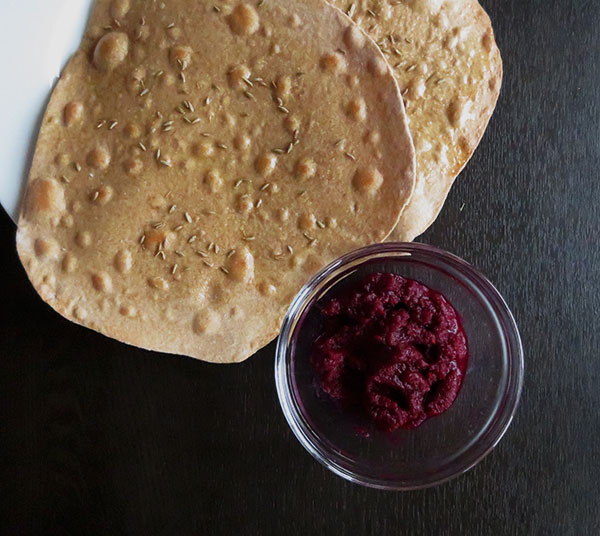
I closely followed the recipe from Fresh Pantry with only one substitution. I replaced the same amount of white flour with my new Einka flour to make the flatbreads 100% whole wheat.
But Sometimes You’ve Got To Wing It
I find I rely on the easy recipes in kitchenlister more often than I ever expected to. Still, sometimes the combination of ingredients I want to use doesn’t return results. That’s when you need to get creative and make it up. And so I give you:
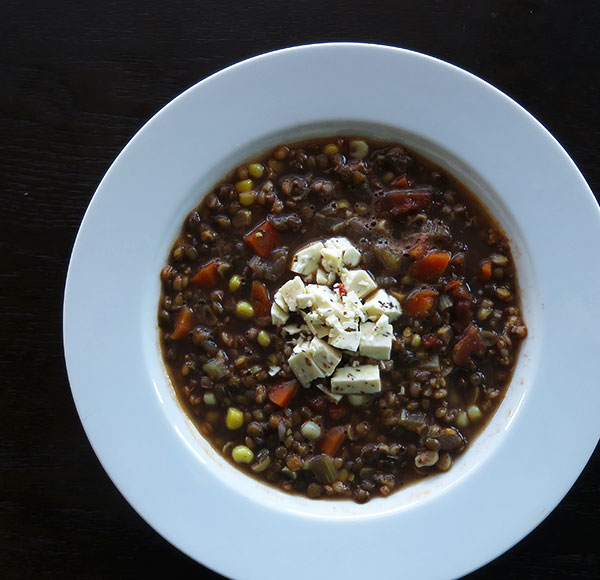
I wanted to try the Einka and lentil blend from my new CSA. A soup suggestion is printed right on the bag. Making the soup is not much different than cooking the grain itself. Add more liquid and flavoring ingredients. I chose the additions based on the list of ingredients in my freezer. Homemade mirepoix, plum tomatoes, corn kernels, black bean broth, and lemon juice (frozen in ice cube trays). I added chopped garlic and a little butter to the vegetables and cut the bean broth with water. I garnished the soup with the last of my feta cheese.
I’ve been making a version of tuna pasta for years. The original recipe I started with was from The Joy of Cooking. It combined anchovies, olives and capers. No wonder I loved it. After starting kitchenlister, I found some new variations, like this and this. So I started incorporating fresh herbs and citrus zest. At this point, I don’t use a recipe at all anymore. I improvise something based on what I have at the moment and what sounds good.
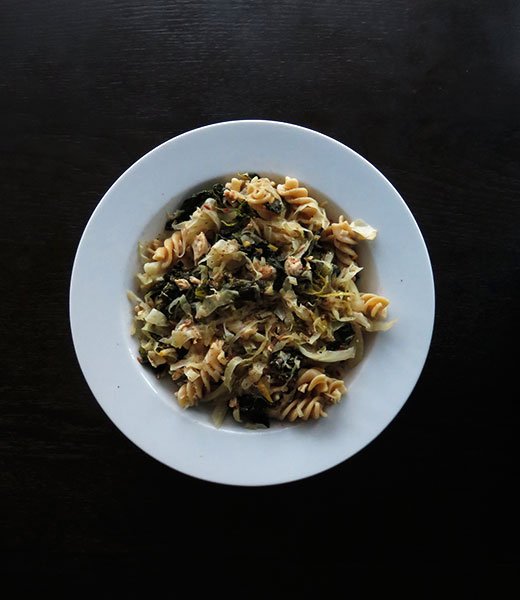
The pasta-vegetable-fish combo is a handy formula that always satisfies me. So I’m working on a YouTube video that will help you start improvising your own pastas. The most important thing to remember: The quality of the fish you buy matters more than anything else. If you only want to buy cheap tuna, please don’t bother making this.
For more pasta seasonal pasta ideas, read this post.
And Other Times You Can Do Both
I’ve talked about baked oatmeal before. It’s one of those dishes that I always use a base recipe for and rarely, if ever, follow. To me it’s that perfect combination. Complicated enough to be something special. Adaptable enough to feel like I’m eating something new. The promise of reliable leftovers (which can be frozen if needed) makes it dependable. It also takes well to my number one rule for reserving leftovers: Vary the garnishes. For baked oatmeal, that usually means changing the fruit and syrup.
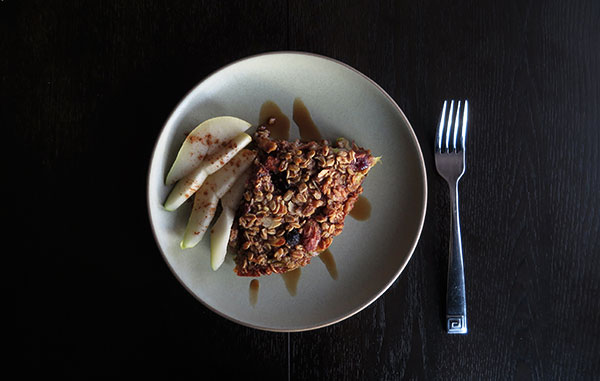
I do follow my own rules. So I made extra flatbread dough on Wednesday and stored it in the fridge. Using the beet puree recipe as a template, I whipped up a broccoli hummus. I served it with the freshly-baked flatbreads and pan-fried haloumi cheese. A very easy and delicious end to the week. Made that much better served with beer.
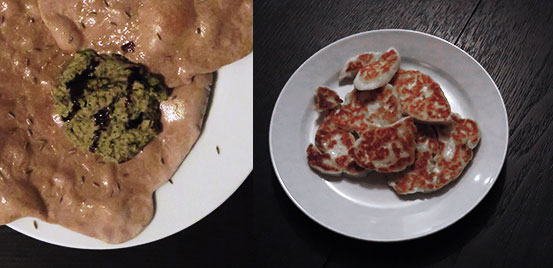
Haloumi is a long-keeping cheese I try to always have in my fridge. Once again, I used all parts of the Meyer lemon in my broccoli puree.
Okay, But You Bought Some Stuff, Right?
True. Yes, I did go to the store AND the night market this week. Actually both on the same day. I’m multi-tasking, after all. I mostly bought citrus at the grocery store—I was there to take advantage of citrus days, in fact. Of the produce I bought at the market, I only used the kale, a quarter of the cabbage and one of the pears this week. Minimal time (1 hr shopping, door-to-door, on foot) and money ($21, including beer and a macaron)* spent. Lots of good eating (15 meals for two people. Not counting leftovers available for the following week).
Now For Something Completely Different
Slightly off topic and probably relevant to almost no one … a momentary celebration of a problem I’ve been trying to solve for literally years. It seems so obvious now, but this one took me a while. The canning syrup from home-canned fruit. What to do with it? I don’t can, but my mom does, and so I eat a lot of canned fruit, especially in winter. (If you’ve never had it, I assure you it’s nothing like commercially-canned fruit.) There’s always a generous amount of the syrupy canning liquid left in each jar. I’ve poured it down the drain before, but it always pains me. I just know there’s something I can do with it. So I started freezing it (not a surprise, right?). But I still had no plan about how to use it. Then, after thawing it all to poach the rhubarb this week, I was faced with re-freezing it. Argh! Then suddenly, inspiration:
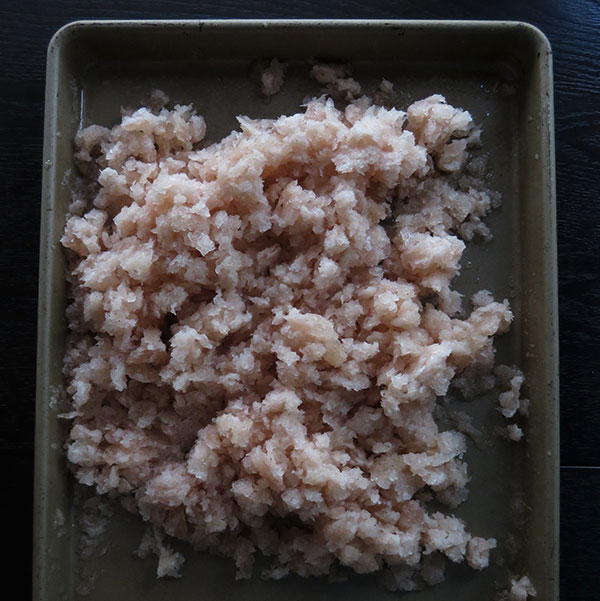
I am not only telling you this to brag (well, a little bit, yes). But it also reminded me that granitas are a perfect light dessert. And you don’t need any special equipment, like an ice cream maker. Here’s a couple easy recipes to try: one with alcohol and one without.
One final note here. If your freezer is anything like mine and packed full (good job!), finding a flat spot for a tray full of liquid may be a trick. I poured the liquid in a bowl for the first hour or two of freezing. Periodically I mixed the solid layer that formed on top into the liquid below. When it was still very slushy but no longer a flowable liquid, I transferred it to a sheet pan. I wedged the pan into the top of the freezer. It wasn’t a completely flat spot, but I no longer needed to worry about spilling the liquid. Granita is forgiving; it turned out perfect.
*Full disclosure: The cost does not include the price of items purchased but not used during the week. Most of the produce and other ingredients I bought are still in my fridge and pantry for next week or after. I realize a full cost break-down for the week may be more useful. But given that many of the foods are from last summer, the total cost of each meal is impossible to determine. Anyhow, I am not trying to claim these meals are cheap. Rather I want to show how to limit spending in any given week by using the foods you already have in your kitchen. The goal here is to reduce waste instead of needlessly buying more food.
KEEP TRACK OF THE INGREDIENTS IN YOUR FREEZER, FRIDGE AND EVERYWHERE ELSE IN YOUR KITCHEN. CREATE A FREE ACCOUNT WITH KITCHENLISTER.
If you’d like more information about any of these winter meals, leave me a comment.
Read more about my “Week in Review” posts.
